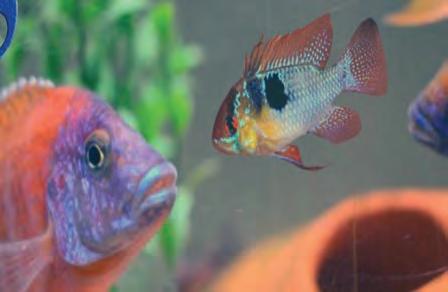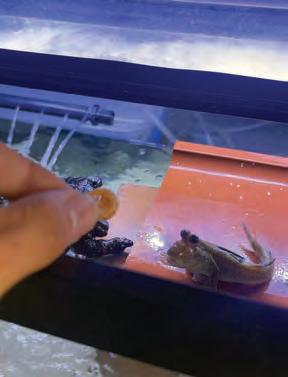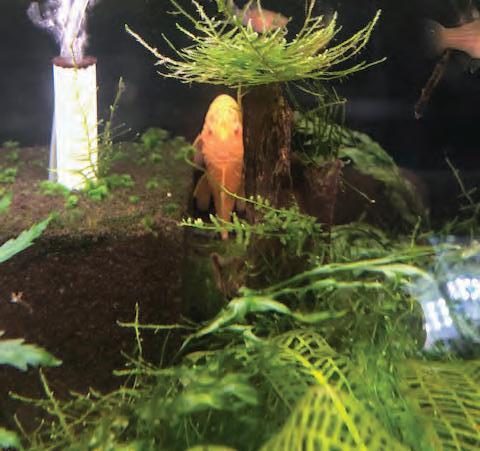A NURSE and NOT A MAID
Story and Photos by Stephen Sica
The last time that Donna, Cordelia and I had been in Key Largo was in October 2019, just prior to the pandemic. One of our routines is to take both our dog and ourselves for a walk along the wharf that runs along the narrow canal where the various boats dock. We finally returned in May 2023 and recalled that we had encountered a fishing boat operator who gutted fish at a stationary cleaning table next to the canal. He threw the entrails right into the water to a group of small nurse sharks. This activity seems to have begun in 2019. We had never seen it before. Of course we had forgotten about this, but as we were walking late on a Saturday afternoon we came across this unique occurrence again, and refreshed our memories. The small boat had returned from another day of fishing, and the captain or mate was cleaning the day’s catch. We peered into the water to find a group of nurse sharks swimming in a tight circle, angling for another free meal.



We found this fascinating, because we never see nurse sharks from a topside view, we observe them underwater. I must say that they appear more detailed on the surface. Their brown skin color is evident and a peek at a blue eye above the water is also interesting. I remember that I authored a brief article for Modern Aquarium a few years ago about this very occurrence. Here it is more than three months after our encounter, and I’m thinking to myself that our illustrious editor, Dan Radebaugh, is always in need of articles. Most members of the Greater City Aquarium Society, excluding those who volunteer for other duties, do not author articles for Modern Aquarium. Hey out there! You can easily write one story once a year!
I’m not an expert aquarist. I just like fish. I call my works stories, as opposed to articles, because I’m reluctant, but more likely unable, to be expert and scientific unless I look it up. Who wants to always look it up?
Modern Aquarium - Greater City A.S (NY) October 2023 15
The trigger finger on my camera hand couldn't resist photographing a sea bird, in this example a majestic pelican, as we walked Cordelia along the boat canal in search of fish life.
The canal where dive and pleasure boats tie up and traverse to the open ocean about a mile away. At the entrance are pricey private homes and near the end are a few hotels and restaurants.
A local fisherman or boat captain cleans the day's catch and discards entrails into the canal.
It’s difficult to write about something different every month—ask Joe Ferdenzi and a few other members! Both my mind and my physical being have lost a step or two during the past few years, so it is more difficult these days to think up new ideas. This is why I’m writing about these same nurse sharks again! I do wonder if all the sharks that I saw in May are the same ones that I saw a few years ago. Do they swim out to sea in the evening, or just hang around the boat canal? Sharks usually feed in the evening as the sun is setting. It is difficult for their prey to see them, and that also goes for humans!
These are the kinds of sharks that keep a low profile. If you watch “Shark Week” type documentaries on cable television, one of their occasional themes or sidebars might be about sharks eating pup and smaller sharks. Although nurse sharks can grow to fourteen feet or so, most adults are in the five to eight foot range. I’ve seen one or two eight footers. Nurse sharks lie on the bottom in or near a reef that offers protection. Many years ago, during a sunset dive in Key West, Donna and I came across an exceptionally large nurse shark lying in the sand. I cannot recall if I had a camera to film the fish, but I can see it in my mind right now. During night dives, you can’t help thinking about what lies out there beyond
your limited vision. Is a big fish behind me? Is it a shark? It can get spooky! They often use these same themes on shark television shows. “Cover my back!” Sometimes it does sound silly to me—but you never know! Look at the poor lady who was bitten at Rockaway Beach a few weeks ago. I do know that many sharks swim to and fro about one hundred yards off the beach. When I was sixteen years old and scuba diving in Reynold’s Channel at formerly Beach 8th Street, a medium size shark swam past me heading towards the open sea. The water was fifteen to twenty feet deep and only a few yards off the beach.
For those readers with a scientific bent, let’s again review a bit of information about the nurse shark. If you do not want to call a nurse shark a nurse shark, please refer to it as Ginglymostoma cirratum. Specimens as long as fourteen feet have been caught, but a decent size nurse shark would usually be between eight to ten feet. Its skin tone is brownish— most of them have a bluish tint to their eyes, and, I believe it is the only shark with obvious barbels used in searching for food. Some other sharks have barbels, but they are not obvious. Its teeth are mostly flat on their surfaces and have developed into grinders. This shark does not tear apart its prey with sharp serrated teeth. This fish is non-aggressive unless provoked. I have not heard of a fatal attack by a nurse shark, but once I did see a video on television of a nurse shark that bit a diver who pulled on its tail. I guess that you can sum up this shark’s disposition as “live and let live.” If this is the case, don’t expect to see any “Shark Week” documentaries about this fish.



Modern Aquarium - Greater City A.S (NY) 16 October 2023
Fish entrails from this catch lure the nurse sharks from the open ocean into the boat canal.
by John Todaro
Are there other life forms in the universe? Have you ever wanted to meet alien life? Well, you can do that right here on Earth at the water’s edge. We know these aliens as fish. They live in a totally alien world to ours, in which we can not survive without special breathing equipment and “space ships” that allow us to enter the world they live in. Let’s take a look at how they live in their world.

Of the 42,000 different types of vertebrates in the world, about half of them are fish. About 60% live in the oceans and the rest, about 40%, live in freshwater. These aliens range in size from about 6mm long to many feet long.
Breathing under water
How do these aliens survive in this unforgiving water world? How do they breathe? Do they breathe water? No. They need oxygen to live, just like we do. So how do they do it in water? The supply of oxygen is essential to life but it’s more difficult to obtain in water than it is in air because water contains only 2% to 3% as much oxygen as air.
Water is 800 times more dense than air and much harder to move through their breathing system. Fish don’t have lungs, except for anabantids. More about them later. All fish have gills, and to stay alive in their world they must pass large volumes of water through the

Modern Aquarium - Greater City A.S (NY) October 2023 17
This article is reprinted from the May-June, 2019 issue of the Brooklyn Aquarium Society s Aquatica.
gills to extract oxygen through the gills pumping action. When fish begin to run out of oxygen, the very best they can do is to increase the oxygen supply 2 to 3 times by pumping their gills faster. We humans can increase our supply 20 times or even more by deeper and faster breathing. Now to anabantids in this alien world. You may know them as labyrinth fish or gouramis or bettas. These fish have developed a labyrinth organ, a defining characteristic of fish in the suborder Anabantoidei. It is a muchfolded suprabranchial accessory breathing organ, formed by vascularized expansion of the epibranchial bone of the first gill arch and used for breathing in air.
This special organ allows labyrinth fish to take in oxygen directly from the surface of the water, instead of taking it from the water they live in. The labyrinth organ helps the inhaled oxygen to be absorbed into the bloodstream. So labyrinth fish can survive for short periods of time out of water because they can inhale the air in our world, provided the fish stay wet and the air is moist.
Labyrinth fish are not born with functional labyrinth organs. The development of the organ is gradual, and most young
labyrinth fish breathe entirely with their gills, developing the labyrinth organs as they grow older.
The reason these fish developed this organ is that they generally live in waters stagnant and low in oxygen, and this organ enables them to gulp a bubble of air from the water surface.
Species living in lowoxygenated waters are more likely to have larger and more complex labyrinth organs than species found in fast-flowing, oxygen-rich waters.
Our ears are not very well adapted to detecting sounds in this alien world of water, and until the invention of hydrophones we assumed that the oceans were silent. Scientists were surprised to find that the waters of the world are very noisy—even more so than the world we live in. This high noise level is caused by water’s greater density, and it can transmit sound

Modern Aquarium - Greater City A.S (NY) 18 October 2023
much further. Much of the noise in the water comes from fish. They make sounds to frighten an enemy or to attract a mate. They make sounds by grinding their teeth or vibrating some part of their anatomical systems such as the swim bladder.
Some fish make noise when eating; for example, parrotfish do when they scrape sections of coral, and rays when they crunch mollus shells. Some small toadfish can make a sound with an intensity of 90 decibels! Even water turbulence created by a school of fish produces noise. It can be heard by us and has given rise to such fish names as grunts, drum, and croakers.
Most sounds are in the form of grunts, whoops, clicks, thumps, growls and barks, and most of them are within the range of human hearing when transmitted through hydrophones.
Physical Hearing Adaptations
Sound perception organs in fishes include cilia (nerve hairs), bladders, ossicles, otoliths, accelerometers and mechanoreceptors in various configurations. Some fish have all of these features; some have only one.

But regardless of the complexity of adaptations, all fish in the alien world of water that we know of seem to respond to sound.
The lateral line along the side of some fishes is an interesting adaption to their world of water. Lateral lines are comprised of cilia that are akin to the cilia that line the cochlea of the inner ears of terrestrial vertebrates. Some
fish don’t have lateral lines, but do have cilia that serve as mechanoreceptors, translating acoustically induced particle motion and pressure gradients into the sensory system of the fish.
By way of these two acoustical energy perceptions, they sense sound and the proximity of other moving bodies, and thus help fish to hold together in their tightly synchronized schools and not bump into each other.
Many fish also have gasfilled swim bladders that are
Modern Aquarium - Greater City A.S (NY) October 2023 19
used to mediate buoyancy. These bladders also represent an acoustical impedance differential in the body and can serve as a pressure gradient sensor. In some fishes, the swim bladder ties into the inner ‛ears’ of the fish by way of a set of bones similar to those in our own middle ear. Another hearing organ of fish is an Accelerometer, set up by dense bones in the skull called otoliths, which sense particle motion.
How Fish See
Fishes’ eyes are very much like those of humans, and in many species of fish they’re well developed, but there are major differences. Fish eyes function independently of each other and can be rotated to take in a wide area on each side of the body. Since the furthest that can be seen underwater with clarity is about 82 feet, there’s little provision for focal adjustment, and because fishes’ eyes are being constantly kept wet with water, fish generally don’t have eyelids.
Not all creatures in our terrestrial world with eyes see in color; of all the mammals, only humans and primates are able to see color. Your dog and cat do not see color. In the alien world of water however, most fish see
color, judging from the existence of color receptors cells in their eyes.
Deep water fish that live in the “twilight zone” where there is little light, have very few color receptor cells and may not see in the full spectrum of color. On the other hand, fish living in or about coral reefs and in shallow sun-drenched waters are well equipped with color receptors, and see in living color.
Fish and other aquatic animals live in a different light environment from terrestrial species. Water absorbs the light spectrum, so that with increasing depth the amount of light available to see with decreases quickly. The optical properties of water also lead to different wave-lengths of light being absorbed to different degrees.
For example, visible light of long wavelengths (e.g., red, orange) is absorbed in less water than light of shorter wavelengths (green, blue). Ultraviolet light (even shorter wavelength than violet) can penetrate deeper than visual spectrum.
Besides the universal qualities of water, different bodies of water may absorb light of different wavelengths differently, due to varying salt and/or chemical presence in the water.
Modern Aquarium - Greater City A.S (NY) 20 October 2023
Structure and Function
Fish eyes are broadly similar to those of other vertebrates notably the tetrapods (amphibians, reptiles, birds and mammals all of which evolved from a fish ancestor). Light enters the eye via the cornea, passing through the pupil to reach the lens. Most fish species seem to have a fixed pupil size, but elasmobranchs (like sharks and rays) have a muscular iris which allows pupil diameter to be adjusted. Pupil shape varies, and may be either circular or slitlike.
Lenses are normally spherical, but can be slightly elliptical in some species. Compared to terrestrial vertebrates, fish lenses are generally more dense and spherical. In water there’s not a major difference in the refractive index of the cornea and the surrounding water (compared to air or land), so the lens has to do the majority of the refraction. The spherical lenses of fish are able to form sharp images free from spherical aberration. Once light passes through the lens it’s transmitted through a transparent liquid medium until it reaches the retina, which contains the photoreceptors.
As in other vertebrates, the photoreceptors are on the inside layer, so light must pass through
layers of other neurons before it reaches the retina which contains rod cells and cone cells.
The ratio of rods to cones depends on the ecology of the fish species concerned, e.g., those mainly active during the day in clear waters will have more cones than those living in low light environments. Color vision is most useful near the surface in clear waters, rather than in deeper water where only a narrow band of wavelengths persist.
The distribution of photoreceptors across the retina is not uniform. Some areas have higher densities of cone cells, for example. Fish may have two or three areas specialized for high acuity (e.g., for prey capture) or sensitivity (e.g., from dim light coming from below). The distribution of photoreceptors may also change in the case when the species typically moves between different light environments during its life cycle (e.g., shallow to deep waters, or fresh water to ocean) or when food spectrum changes accompany the growth of a fish, as seen with the Antarctic icefish Champsocephalus gunnari.
Some species have a tapetum, a reflective layer which bounces light that passes through the retina back through it again.
Modern Aquarium - Greater City A.S (NY) October 2023 21
This enhances sensitivity in low light conditions, such as deep sea species, by giving photons a second chance to be captured by photoreceptors.
However, this comes at a cost of reduced resolution. Some species of fish are able to turn their tapetum off in bright conditions, with a dark pigment layer covering it as needed.
The retina uses a lot of oxygen compared to most other tissues, and is supplied with plentiful oxygenated blood to ensure optimal performance.
Humans have a vestibuloocular reflex, which is a reflex eye movement that stabilizes images on the retina during head movement by producing an eye movement in the direction opposite to head movement, thus preserving the image on the center of the visual field. In a similar manner, fish have a vestibulo-ocular reflex which stabilizes visual images on the retina when it moves its tail to swim.
From Skin to Scales
Scales are semi-transparent, like our fingernails, and grow from the fish’s skin. The number and arrangement of the scales are established genetically and don’t change with age; they merely enlarge with growth.

Overlaying the scales is a thin layer of slimy mucus familiar to anyone who has ever handled a fish; this mucus serves as a barrier to bacterial and fungal infections. The mucus also reduces the friction of water on fishes and it allows them to swim more efficiently in their watery world.

Modification of Scales
Different groups of fishes have evolved a number of modified scales to serve various functions. Almost all fishes have a lateral line, a system of mechanoreceptors that detect movements in water.
In bony fishes, the scales along the lateral line have central pores that allow water to contact the sensory cells.
Modern Aquarium - Greater City A.S (NY) 22 October 2023
• The dorsal fin spines of dogfish sharks and chimaeras, the stinging tail spines of stingrays, and the "saw" teeth of sawfishes and sawsharks are fused and modified placoid scales.
• Porcupine fishes have scales modified into spines.
• Surgeonfishes have sharp, blade-like spines on either side of the caudal peduncle.
• Some herrings, anchovies, and halfbeaks have deciduous scales, which are easily shed and aid in escaping predators.
• Male Percina darters have a row of enlarged caducous scales between the pelvic fins and the anus.
Many groups of bony fishes, including pipefishes and seahorses, several families
of catfishes, sticklebacks, and poachers, have developed external bony plates, structurally resembling placoid scales, as protective armor. In the boxfishes, the plates are all fused together to form a rigid shell enclosing the entire body. These bony plates are not modified scales, but skin that has been ossified.
Lateral Lines
A lateral line is a sense organ fish use to detect movement and vibration in the surrounding water. Fishes use it to detect depth and water pressure, prey, predators, sense current movement and orientation in the current, as well as to avoid collisions. The lateral line is a unique organ that is a combination of eyes, ears and sensory feelings combined into one. All fish have some form of a lateral line; some have a more developed one than others.

Modern Aquarium - Greater City A.S (NY) October 2023 23
The Lateral line is a sensitive receptor which enables fish to dectect currents and vibrations in the water.
Lateral lines are usually visible as faint lines running lengthwise down each side of the fish, from the vicinity of the gill covers to the base of the tail. Sometimes parts of the lateral organ are modified into electroreceptors, which are organs used to detect electrical impulses. It’s possible that vertebrates, such as sharks, use the lateral organs to detect magnetic fields, as amphibians also have a lateral organ.
The development of the lateral-line system depends on the fish's mode of life. For instance, fish that are active swimmers tend to have more neuromasts in canals than they have on their surface, and the line will be farther away from the pectoral fins, which probably reduces the amount of "noise" that is generated by fin motion.
The lateral-line system helps fish to avoid collisions, orient itself in relation to water currents, and to locate prey. For instance, blind cavefish have rows of neuromasts on their heads, which appear to be used to precisely locate food without the use of sight; killifish are able to use their lateral line to sense the ripples made by insects struggling on the water's surface. Experiments have shown that lateral lines in schooling fish are
used to avoid collisions with other schooling fish.
Do Fish Drink?
Yes and no. Fish do drink water, but how they consume it depends on what sort of water they live in.
Water gets into a fish’s body through osmosis, the process in which water diffuses from a higher to a lower concentration.
Freshwater Fish
Here’s how it works. If there is more water outside of a cell than inside, water will try to flow into the cell until there is the same concentration of water on either side of the cell’s membrane.
The body of a fish acts the same way, either absorbing or losing water depending on its surroundings.
Whether a fish absorbs or loses water is based on the fact that all fish must maintain a certain amount of salt in their bodies to stay healthy. Fish that live in freshwater have a higher concentration of salt in their bodies than does t h e surrounding water. So freshwater fish absorb water through their skin and gills. Consequently, water continuously flows into the fish’s body to attempt to dilute the amount of salt in the fish until it is equal to the amount of salt in the surrounding water.
Modern Aquarium - Greater City A.S (NY) 24 October 2023
Since fish cannot allow their salt content to be diminished, their kidneys work overtime to expel excess water in the form of urine. So freshwater fish do not drink, their cells do!
Saltwater Fish
Fish that live in the ocean have the opposite problem. Surrounded by saltwater, their bodies contain a relatively lower concentration of salt than ocean water. In this case, osmosis causes the fish to constantly lose water in order to equalize salt concentration inside and outside the fish.
To partially compensate for the water loss, ocean fish actually drink water through their mouths. To get rid of the excess salt they take in by drinking seawater, they excrete some salt through cells in their gills.
In other words, saltwater fish have to drink because their body's concentration of salt is lower than the surrounding water. Therefore salt water fish must drink huge amounts of water to stay hydrated.
Temperature
In this alien world of water, we have always thought of fish as being cold-blooded, but some species of fish actually maintain a body temperature slightly
higher than the water they are swimming in.
Fishes are surprisingly sensitive to temperature changes; some react to a change of as little as one tenth of a degree F. They have developed to live in a variety of environments in their alien world. There are fish that live in nearly freezing water, and others that live in water as hot as 104°F. Most fish are likely to die if the temperature they are accustomed to changes more than 15°F, and many cannot tolerate even that change.
Temperature at the time of spawning is especially critical to many species, and may be a reason why some fish migrate to special spawning areas at a particular time of the year.
Since most fish are coldblooded, which means they do not and cannot control their internal body warmth, their metabolism is strongly influenced by the temperature of the water in which they live.
A few species, bluefin tuna as an example, are somewhat warm-blooded, in that they can control the temperature of some organs by using muscle movement to generate heat. But as far as is known, most fish are cold-blooded.
Modern Aquarium - Greater City A.S (NY) October 2023 25
Given their cold-blooded nature, fish need to move to stay within their temperature comfort zone. Generally they do not need to move too quickly, because water has a high heat capacity, so generally change in temperature happens slowly. Fish are rarely trapped outside their comfort zone unless exceptional changes happen, such as a fish being trapped in a small landlocked pool on a very hot day, or when there is a large draw-down of a reservoir.
Fish generally try to find their thermal optimum, (their Goldilocks zone) the temperature which is not too cold or not too hot. This thermal optimum varies for different fish species.
Many feel that larger fish have better cold tolerance, and


this may be a factor why larger fish generally live in deeper, colder water than smaller fish. We get to watch creatures living in this alien world behind a glass panel, while sitting comfortably in an easy chair. No rockets to outer space, no space suits. As an aquarist for my whole life, I find this world of fish and other creatures that live in this watery world exciting!
References:
• Wikipedia.org - Vision in fishes
- fish ears

•ORC.org/learn/howdo-fishhear
• Wikipedia.org - fish scales
•laterlineco.com/fish_latera_ line.htm
• åwww.thefishingnut.com

Modern Aquarium - Greater City A.S (NY) 26 October 2023
by Thomas M. Keevin
URBAN LEGENDS HAVE been around for a long time and are always evolving, and changing with the times. They are usually fictional stories associated with the macabre, superstitions, ghosts, demons, dangerous creatures and other fear generating narratives. Such legends often come to life and are shared around the campfire or on Halloween to scare young kids.
Growing up in St. Louis during the 1950’s I heard stories about commercial divers on the Mississippi River not wanting to work at the locks and dams because of the huge fish they encountered while making underwater inspections and repairs. There seemed to be a general fear by the commercial divers that monster catfish and Alligator Gar were lying in wait to attack them while they worked .
While reviewing historical newspaper articles as basis for scientific papers on the historical distribution of the Alligator Gar and the cultural history of the species, I found two articles in the Alton Telegraph that indicated one of the urban legends of my youth may have had some truth behind it.
The 15 June 1942 issue of the Alton Telegraph had an article that reported that J. J. Carver had caught a 7'2", 112 pound Alligator Gar at old Lock and Dam 26 He had shot it in the neck with a .45-caliber revolver and then hit it with a shotgun blast. The fish was lassoed with a rope and pulled out of the Mississippi by four men.
My first thought was why did Mr. Carver have a .45 revolver and a shotgun at Lock and Dam 26 and why did they let him use them to kill a fish?
An Alton Telegraph article published six years later, on 30 June 1948 answered at least one of the gun questions, and also shed some light on why commercial divers might not have been happy about diving at Lock and Dam 26.

The 1948 article stated:
“Giant alligator garfish have been visiting the Alton Lock and Dam during the past week for the first time in five years*. The fish, from six to seven feet in length and weighing about 200 pounds, appeared on the downstream side of the locks when the Missouri River began to rise. Today, the numbers of fish were decreasing, but several of the huge fellows could be seen below the locks, dwarfing any other fish in sight.
In 1943*, the last year that the gars visited the Alton locks, one of them was killed by a guard who was posted on the dam during the war.
This fish measured more than seven feet in length.” *Author : Actually 5 years aft e r the 1942 articl e.

This article also cleared up one of my questions by indicating that the armed guard was there to guard Lock and Dam 26 during World War II. Of course it still didn’t answer the question - Why he could blast away at fish from the lock and dam.
The large aggregation of monster Alligator Gar could certainly put the fear of God into commercial divers and start an urban legend that was in reality true.
Temperature and flood stages experienced at the time of the articles are the factors that initiate Alligator Gar spawning behaviors, as they normally form aggregations and move to the floodplain to spawn during flooding They generally spawn in June in our part of the Mississippi River - the month of publication for both articles.
The Alligator Gar no longer occurs in the Mississippi River within the St. Louis District of the Corps of Engineers, although stocking efforts by both Illinois and Missouri are in progress.
Modern Aquarium - Greater City A.S (NY) October 2023 27
This article is reprinted from the Missouri Aquarium Society ’ s March/April 2022 issue of the The Darter.













 by Greater City Aquarium Society Fishy Friends
by Greater City Aquarium Society Fishy Friends













































































